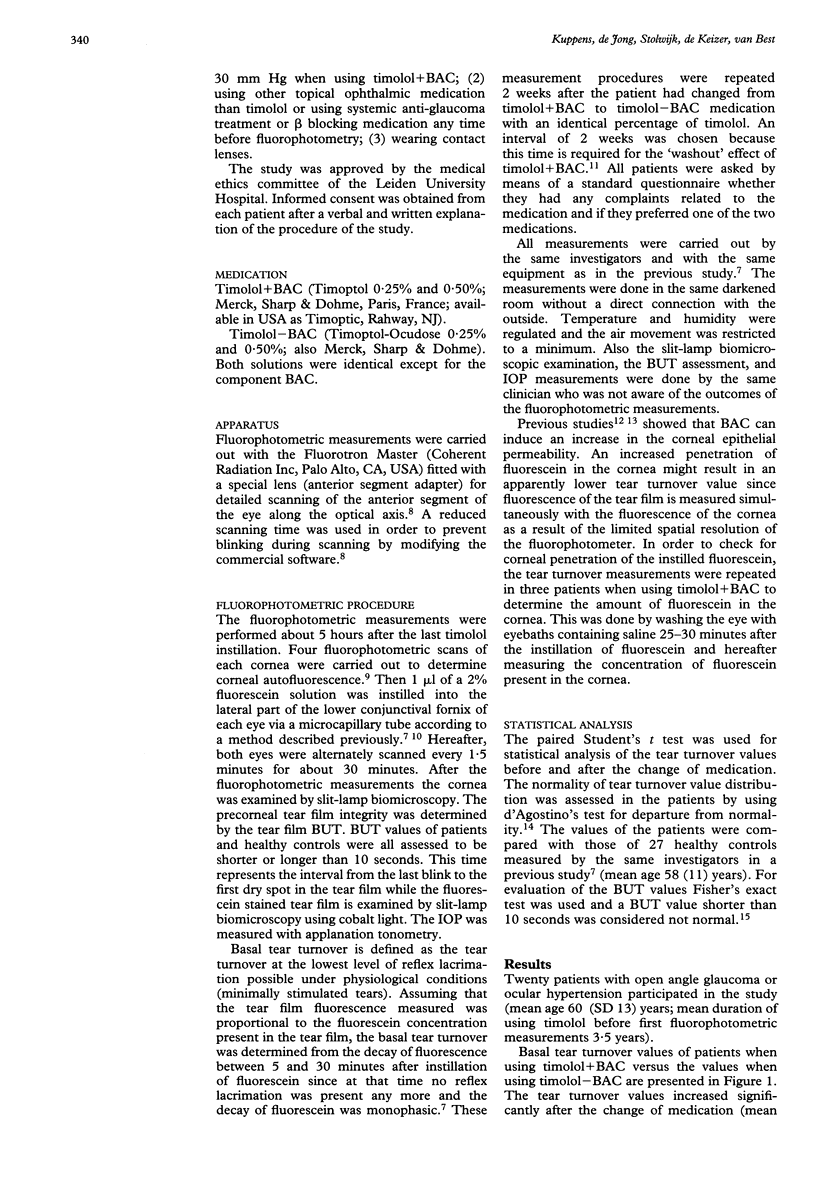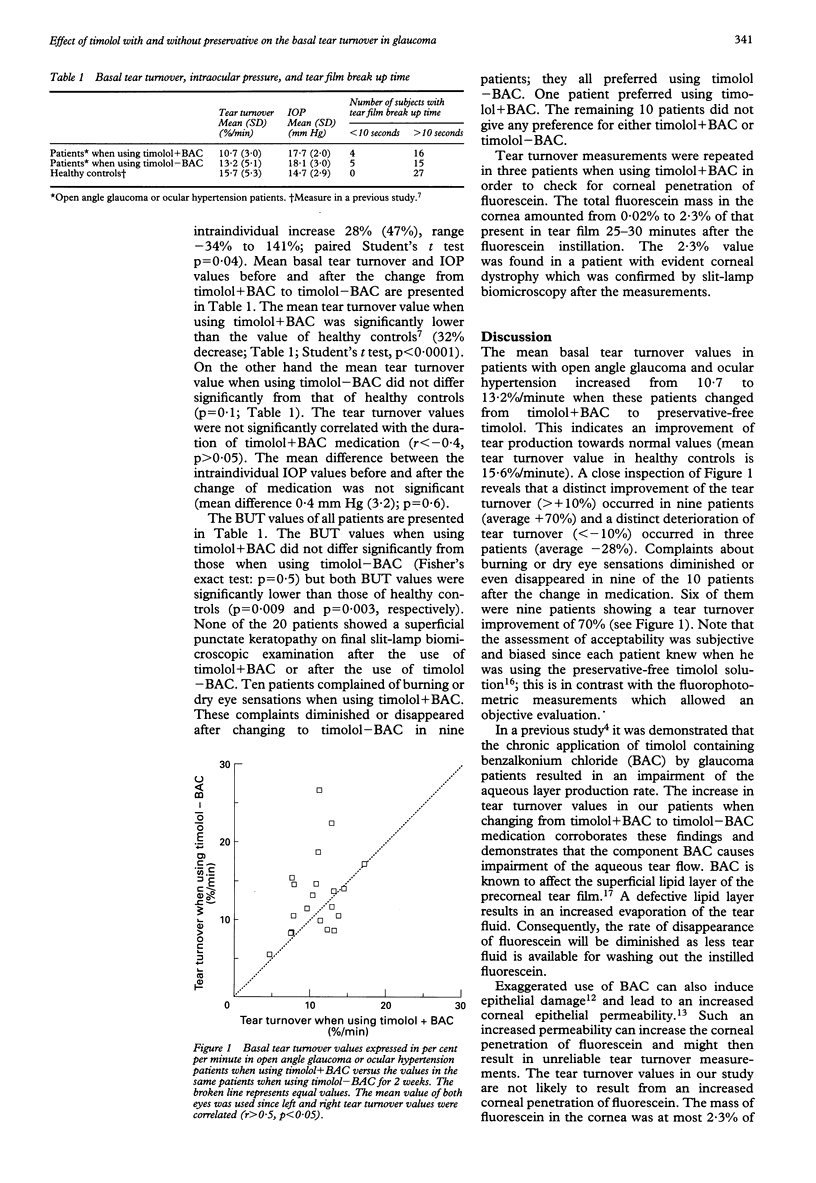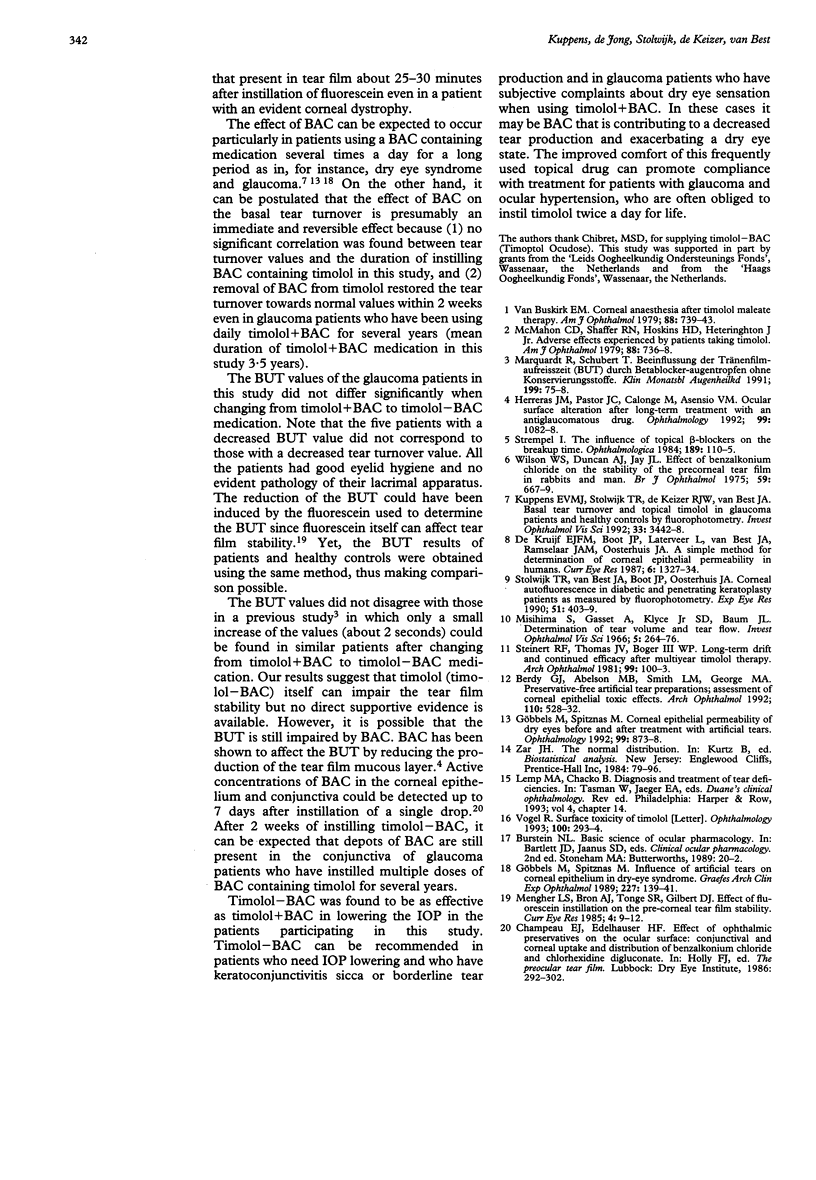Abstract
AIMS--The purpose of this study was to assess whether the preservative benzalkonium chloride (BAC 0.01%) present in timolol induced a decrease in basal tear turnover and a deterioration of precorneal tear film in patients with glaucoma and ocular hypertension using topical timolol. METHODS--The basal tear turnover of 20 patients with open angle glaucoma or ocular hypertension was measured by computerised objective fluorophotometry when using topical timolol preserved with BAC and 2 weeks after changing to topical timolol containing no preservative. Evaluation of the precorneal tear film was done by measuring the break up time (BUT) before and 2 weeks after changing medication. RESULTS--The tear turnover of the patients before the change was 32% lower than that of healthy controls (mean tear turnover values (SD) (%/min): 10.7 (3.0) and 15.6 (5.4), respectively, p < 0.0001). A mean increase of 28% (47%) in the individual tear turnover values was found after the change to the preservative-free timolol (p = 0.04). The BUT values before the change of medication did not differ significantly from those after the change (p = 0.5) but both values were significantly lower than the values of healthy controls (p = 0.009 and p = 0.003, respectively). CONCLUSION--Preservative-free timolol solution has a favourable effect on the tear turnover of patients with glaucoma and ocular hypertension in comparison with timolol containing BAC. The integrity of the precorneal tear film persisted to be affected when using timolol without BAC. Timolol without preservative can be recommended in those patients who have keratoconjunctivitis sicca or a borderline tear production since BAC may exacerbate a dry eye state.
Full text
PDF



Selected References
These references are in PubMed. This may not be the complete list of references from this article.
- Berdy G. J., Abelson M. B., Smith L. M., George M. A. Preservative-free artificial tear preparations. Assessment of corneal epithelial toxic effects. Arch Ophthalmol. 1992 Apr;110(4):528–532. doi: 10.1001/archopht.1992.01080160106043. [DOI] [PubMed] [Google Scholar]
- Göbbels M., Spitznas M. Corneal epithelial permeability of dry eyes before and after treatment with artificial tears. Ophthalmology. 1992 Jun;99(6):873–878. doi: 10.1016/s0161-6420(92)31879-2. [DOI] [PubMed] [Google Scholar]
- Göbbels M., Spitznas M. Influence of artificial tears on corneal epithelium in dry-eye syndrome. Graefes Arch Clin Exp Ophthalmol. 1989;227(2):139–141. doi: 10.1007/BF02169786. [DOI] [PubMed] [Google Scholar]
- Herreras J. M., Pastor J. C., Calonge M., Asensio V. M. Ocular surface alteration after long-term treatment with an antiglaucomatous drug. Ophthalmology. 1992 Jul;99(7):1082–1088. doi: 10.1016/s0161-6420(92)31847-0. [DOI] [PubMed] [Google Scholar]
- Kuppens E. V., Stolwijk T. R., de Keizer R. J., van Best J. A. Basal tear turnover and topical timolol in glaucoma patients and healthy controls by fluorophotometry. Invest Ophthalmol Vis Sci. 1992 Nov;33(12):3442–3448. [PubMed] [Google Scholar]
- Marquardt R., Schubert T. Beeinflussung der Tränenfilmaufreisszeit (BUT) durch Betablocker-Augentropfen ohne Konservierungsstoffe. Klin Monbl Augenheilkd. 1991 Aug;199(2):75–78. doi: 10.1055/s-2008-1046051. [DOI] [PubMed] [Google Scholar]
- McMahon C. D., Shaffer R. N., Hoskins H. D., Jr, Hetherington J., Jr Adverse effects experienced by patients taking timolol. Am J Ophthalmol. 1979 Oct;88(4):736–738. doi: 10.1016/0002-9394(79)90674-3. [DOI] [PubMed] [Google Scholar]
- Mengher L. S., Bron A. J., Tonge S. R., Gilbert D. J. Effect of fluorescein instillation on the pre-corneal tear film stability. Curr Eye Res. 1985 Jan;4(1):9–12. doi: 10.3109/02713688508999961. [DOI] [PubMed] [Google Scholar]
- Mishima S., Gasset A., Klyce S. D., Jr, Baum J. L. Determination of tear volume and tear flow. Invest Ophthalmol. 1966 Jun;5(3):264–276. [PubMed] [Google Scholar]
- Steinert R. F., Thomas J. V., Boger W. P., 3rd Long-term drift and continued efficacy after multiyear timolol therapy. Arch Ophthalmol. 1981 Jan;99(1):100–103. doi: 10.1001/archopht.1981.03930010102012. [DOI] [PubMed] [Google Scholar]
- Stolwijk T. R., van Best J. A., Boot J. P., Oosterhuis J. A. Corneal autofluorescence in diabetic and penetrating keratoplasty patients as measured by fluorophotometry. Exp Eye Res. 1990 Oct;51(4):403–409. doi: 10.1016/0014-4835(90)90152-k. [DOI] [PubMed] [Google Scholar]
- Strempel I. The influence of topical beta-blockers on the breakup time. Ophthalmologica. 1984;189(3):110–115. doi: 10.1159/000309394. [DOI] [PubMed] [Google Scholar]
- Van Buskirk E. M. Corneal anesthesia after timolol maleate therapy. Am J Ophthalmol. 1979 Oct;88(4):739–743. doi: 10.1016/0002-9394(79)90675-5. [DOI] [PubMed] [Google Scholar]
- Vogel R. Surface toxicity of timolol. Ophthalmology. 1993 Mar;100(3):293–294. doi: 10.1016/s0161-6420(13)32168-x. [DOI] [PubMed] [Google Scholar]
- Wilson W. S., Duncan A. J., Jay J. L. Effect of benzalkonium chloride on the stability of the precorneal tear film in rabbit and man. Br J Ophthalmol. 1975 Nov;59(11):667–669. doi: 10.1136/bjo.59.11.667. [DOI] [PMC free article] [PubMed] [Google Scholar]
- de Kruijf E. J., Boot J. P., Laterveer L., van Best J. A., Ramselaar J. A., Oosterhuis J. A. A simple method for determination of corneal epithelial permeability in humans. Curr Eye Res. 1987 Nov;6(11):1327–1334. doi: 10.3109/02713688708997558. [DOI] [PubMed] [Google Scholar]


